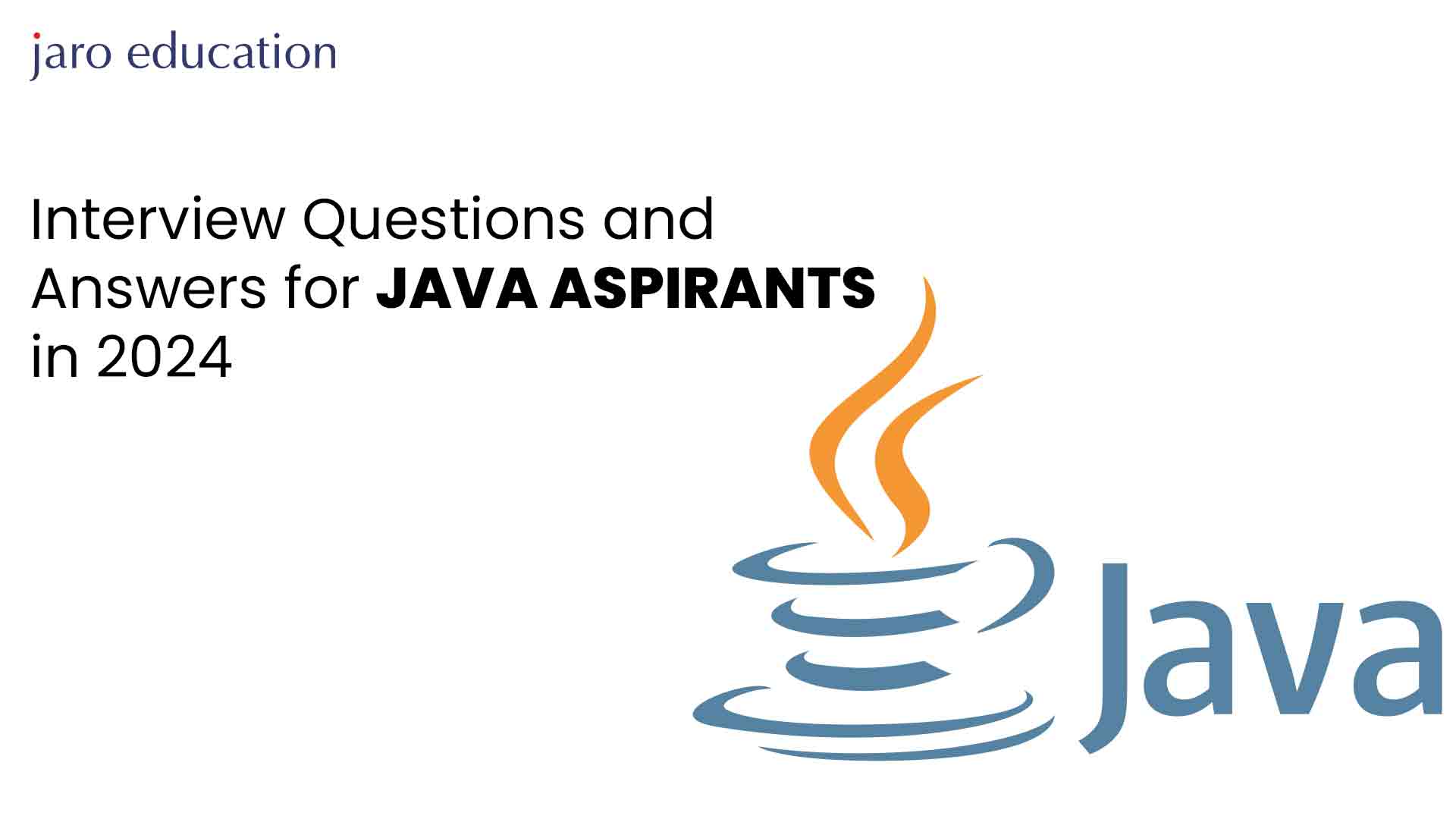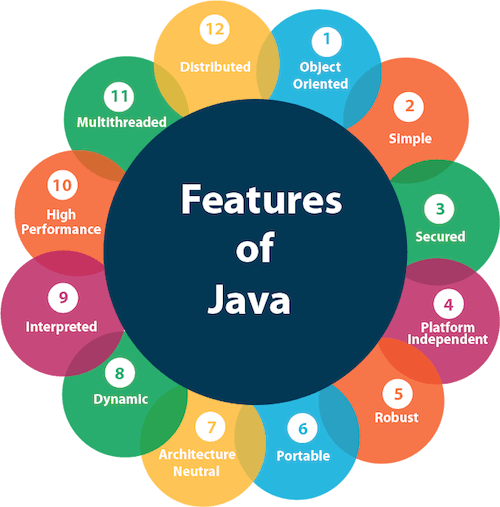Interview Questions and Answers for Java Aspirants in 2024
Table of Contents

- jaro education
- 10, March 2024
- 2:00 pm
In 2024, the demand for skilled Java developers remains as high as ever, with countless opportunities in various industries worldwide. Aspiring Java developers are often required to demonstrate their theoretical knowledge and practical problem-solving skills during interviews. To help Java aspirants prepare, this resource provides a comprehensive collection of Java interview questions and answers customized to the current scenario of Java development in 2024.
Java Interview Questions and Answers for Freshers
The top Java interview questions are given below:
1. What is Java?
Java is a high-level, object-oriented programming language developed by Sun Microsystems (now owned by Oracle Corporation). It is designed to be platform-independent, meaning it can run on any device with a Java Virtual Machine (JVM) installed.
2. What are the differences between C++ and Java?
C++ is a statically typed language with features like pointers and manual memory management, while Java is dynamically typed and uses automatic garbage collection. C++ allows direct memory manipulation and has multiple inheritance, whereas Java does not support these features to ensure safety and simplicity.
3. Why is Java a platform-independent language?
Java achieves platform independence through its “write once, run anywhere” principle. This means that Java code can be compiled into bytecode, which can then be executed on any platform with a JVM, regardless of the underlying hardware or operating system.
4. List the features of the Java Programming language.
Some key features of Java include platform independence, object-oriented programming, automatic memory management (garbage collection), robustness, security, multithreading, and portability.
5. Why is Java not a pure object-oriented language?
Java is not considered a pure object-oriented language because it supports primitive data types (e.g., int, float) which are not objects. Additionally, Java allows procedural programming constructs, such as static methods and variables, which do not belong to any specific object.
6. Explain JVM, JRE, and JDK.
JVM (Java Virtual Machine) is a runtime environment that executes Java bytecode. JRE (Java Runtime Environment) includes JVM, libraries, and other components necessary to run Java applications. JDK (Java Development Kit) is a complete development kit that includes JRE along with tools for compiling, debugging, and monitoring Java programs.
7. What do you get in the Java download file?
In a Java download file, you typically get the Java Development Kit (JDK), which includes the Java compiler, runtime environment, libraries, documentation, and various tools for Java development.
8. What are the differences between Heap and Stack Memory in Java?
Heap memory is used for dynamic memory allocation, primarily for objects, while stack memory is used for static memory allocation, primarily for method calls and local variables. Heap memory is shared among all threads, while each thread has its own stack memory. Additionally, heap memory is managed by garbage collection, while stack memory is automatically managed by the JVM.

*javatpoint.com
9. What is a ClassLoader?
ClassLoader is a subsystem of JVM responsible for loading classes into memory at runtime. It dynamically loads Java classes as they are referenced by a Java program.
10. What are the Memory Allocations available in Java?
In Java, memory allocation includes two main areas: heap memory and stack memory.
11. Why doesn't Java make use of pointers?
Java avoids using pointers because they are complex and unsafe, especially for beginner programmers. Pointer usage can complicate code and introduce potential errors, impacting code simplicity and security. Moreover, the direct memory access provided by pointers can compromise system security. By using references instead of pointers, Java ensures a certain level of abstraction and simplifies memory management, particularly with garbage collection.
12. Define instance variable and local variable.
Instance variables: These variables describe the properties of an object and are bound to the object throughout its lifecycle.
Local variables: They are temporary and exist only within the scope of the method or block in which they are declared.
13. What's the difference between equals() method and equality operator (==) in Java?
The difference between the equals() method and the equality operator (==) in Java are:
- The equality operator (==) checks if two references point to the same object, whereas the equals() method compares the content or state of objects.
- While both are used to compare values, the equality operator compares references, while equals() compares actual content.
14. Why is the main method marked as static in Java?
The main method is marked as static in Java, so the JVM can call it to start the application. If the main method were not static, the Java process wouldn’t know which method to call to begin executing the program.
15. Why is creating static variables not advisable in Java?
Static variables are shared among all objects in a class, so there’s no need to validate their value for each new object. However, this lack of validation can lead to unpredictable behavior as the state of a class can vary. Additionally, static variables go against the principles of Object-Oriented Programming, as they don’t belong to any specific object but rather to the class itself.
16. When do we use a static block in Java?
A static block is used when a class has static member variables that require complex initialization. It allows for the initialization of these variables before the main block executes, providing a way to handle complex static member variable initialization.
17. What's the difference between a static method and an instance method in Java?
A static method is used for actions that are not dependent on object-specific member variables, whereas an instance method operates on the specific instance of the class. Static methods are invoked using the class name, while instance methods require an object to be instantiated before invocation.
18. How do you implement method overloading in Java?
Method overloading in Java involves creating multiple methods with the same name but different parameters, such as a different number or data type of parameters or a different sequence of parameter data types.
19. What are the types of argument variations allowed in method overloading in Java?
Method overloading allows variations in the number of parameters, the data type of parameters, and the sequence of parameter data types.
20. Can we override a static method in Java?
No, Java does not allow static methods to be overridden. If a subclass defines a static method with the same name as a static method in the superclass, it’s considered a different method, not an override.
21. What are the differences between method overloading and overriding in Java?
Method overloading is static polymorphism occurring within the same class with different parameters. Method overriding is dynamic polymorphism, occurring in two classes with hierarchy relationships with the same method signature.
22. What is Runtime Polymorphism in Java?
Runtime Polymorphism, also known as Dynamic Polymorphism, occurs when the method to be called is determined at runtime based on the type of object. This allows for flexibility in method invocation, as the specific method is not known until runtime.
23. What's the difference between JAR and WAR files in Java?
The differences between JAR and WAR files in Java are:
- JAR (Java Archive) files combine multiple files into a single archive, primarily used for libraries. WAR (Web Application Archive) files store web application resources like XML, Java classes, and JavaServer pages.
- JAR files hold Java classes in a library, while WAR files contain web application resources in the ‘lib’ directory.
- JAR files can store Enterprise Java Bean classes and deployment descriptors, while WAR files contain web modules such as Servlet classes, HTML files, etc.
24. How does HashMap work in Java?
HashMap stores key-value pairs and uses a hash function to organise and retrieve items. It determines the hash value of the key, stores the pair in a specific index of an array, and updates the value if the key already exists. Key features include load factor and resizing threshold.
25. What's the difference between HashMap and HashTable?
The differences between HashMap and HashTable are:
- HashTable is synchronised, while HashMap is not, making HashMap preferable in non-threaded applications for better performance.
- HashTable doesn’t allow null keys or values, whereas HashMap allows one null key and multiple null values.
- HashMap has subclasses like LinkedHashMap, allowing predictable iteration order, which isn’t as straightforward as HashTable.
26. Explain the role of System.gc() and Runtime.gc() methods in Java.
System.gc() and Runtime.gc() methods request the JVM to run the Garbage Collector. While System.gc() is a static method of the System class, Runtime.gc() allows interaction with the JVM through the Runtime class. These methods hint to the JVM to start garbage collection, but the actual timing of collection is determined by the JVM.
27. What happens during the creation of an object in Java?
- Memory allocation reserves space for class instance variables and implementation-specific data.
- Initialization sets default values for the object’s variables.
- Constructors are invoked, starting from the parent classes until reaching the Object class constructor.
- Execution proceeds with the initialization of instance variables and initialization blocks, followed by the execution of the Object class constructor’s body.
28. Explain the object-oriented paradigm.
Object-oriented paradigms centre around objects containing data and methods within their defining class, promoting modularity and reusability.
29. Define an object.
An object in Java represents a real-time entity, embodying state and behaviour through instance variables and methods, instantiated using the new keyword.
30. What is the role of a JIT compiler?
The JIT compiler dynamically translates bytecode into machine code during runtime, enhancing Java program performance by optimising execution.
Conclusion
Mastering Java is essential for aspiring developers in 2024. This collection of important Java interview questions offers a solid foundation for freshers, covering key concepts from platform independence to memory management. With Java’s continued relevance, this resource empowers candidates to excel in their career pursuits.
For a comprehensive understanding of Java, one can apply for the Online MCA Programme, which offers strategic insights covering cloud technology and application development. Professionals get free access to Google Cloud Computing Foundations and Coursera. This globally recognized programme shapes innovative tech leaders amidst evolving landscapes. Be prepared to excel with hands-on training and assessment on ML, Big Data and more.








